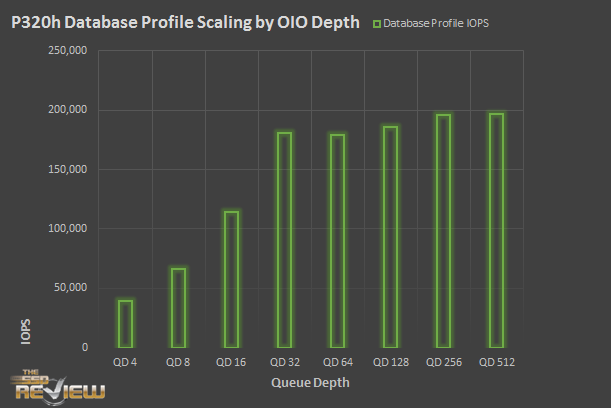SERVER PROFILE TESTING
To perform the server profile testing, we first have to precondition the drive. After a secure erase and 128K sequential fill, each profile is run for five hours at QD 64. After that, we run each profile for one minute at increasing QD.
The database profile is just 8K transfers, but 67% of the operations are reads.
Traditionally, the email server profile would be used. Lately, weve been experimenting with a workload t0 simulate Microsofts Exchange Email server. It breaks down 62% read and 38% write. The regular email server profile is just 8K reads on a 50%/50% read and write split.
The webserver profile is a little more complex. It’s made up of 10 different accesses: 512 bytes (22%), 1K (15%), 2K (8%), 4K (23%), 8K (15%), 16K (2%), 32K (6%), 64K (7%), 128K (1%), and 512K (1%). There are no writes, only reads.
Just out of curiosity, we ran all four traditional server profiles on the P320h for five hours. Each profile is run at a QD of 64, and each profile runs on its own thread. After the performance settles down, the P320h manages 152,000 transactions per second. Each profile levels off around 38K IOPS, despite the difference in access patterns. The Micron P320h seemingly balances the load.
 The SSD Review The Worlds Dedicated SSD Education and Review Resource |
The SSD Review The Worlds Dedicated SSD Education and Review Resource | 


Micron doesnt own the controller. It is made by IDT.
We are aware of that, thanks. Our reasoning behind wording as such is because this is, by no means, a simple stock implementation of a controller and similar could not have been accomplished without Micron’s engineering expertise and software. Great point and perhaps we could reword things just a bit…
Micron has a Minneapolis-based controller team which did much of the work on the controller. Basically, IDT has a stock PCIe controller, but it’s easily modified for custom jobs. Micron refined the design for the P320h. IDT now has a reference NVMe design, but the NVMe standard is far from universal yet. One day, a PCIe SSD won’t need a special driver, but today they do.
Micron developed and owns the chip, IDT just fabs it.
Incorrect. This is the very same controller that is used with the new NVMe controllers that IDT has developed.
Just to help you out, this is what has been posted at Anands after they inadvertently stated it was NVMe.:
Update: Micron tells us that the P320h doesn’t
support NVMe, we are digging to understand how Micron’s controller
differs from the NVMe IDT controller with a similar part number.
Our interpretation of the chip appears to be correct as it is written and this same ‘structure’ has been used in the SSD industry prior. This is not a simple plug and play adaption of a chip, but rather, custom package.
Thanks again.
Yes, it isnt NVMe, but it is an IDT chip, therefore it is not developed in house by Micron.
old news
Just needs a few heat sinks and a fan or maybe a water block to keep it cooler.
Todd – What makes you think you know so much about this chip?
Is the RAIN implementation safe enough to use without RAID 1 running outside of it (say across 2 350GB cards) it sounds good, but if you have a firmware or controller related failure you’re still at risk right?
Is this bootable? And just for kicks, what would the as-ssd results be?